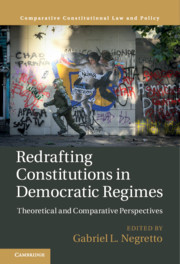Book contents
- Redrafting Constitutions in Democratic Regimes
- Comparative Constitutional Law and Policy
- Redrafting Constitutions in Democratic Regimes
- Copyright page
- Dedication
- Contents
- Tables
- Contributors
- Acknowledgments
- 1 New Constitutions in Democratic Regimes
- Part I Conceptual, Normative, and Empirical Issues
- Part II Case Studies
- 6 The Difference Power Diffusion Makes
- 7 Democratic Constitutional Replacements and Majoritarian Politics
- 8 Thailand’s Democratic Moment
- 9 Political Elites and the People
- 10 The Anatomy of Constitution Making
- Index
- References
8 - Thailand’s Democratic Moment
The Constitution of 1997
from Part II - Case Studies
Published online by Cambridge University Press: 29 August 2020
- Redrafting Constitutions in Democratic Regimes
- Comparative Constitutional Law and Policy
- Redrafting Constitutions in Democratic Regimes
- Copyright page
- Dedication
- Contents
- Tables
- Contributors
- Acknowledgments
- 1 New Constitutions in Democratic Regimes
- Part I Conceptual, Normative, and Empirical Issues
- Part II Case Studies
- 6 The Difference Power Diffusion Makes
- 7 Democratic Constitutional Replacements and Majoritarian Politics
- 8 Thailand’s Democratic Moment
- 9 Political Elites and the People
- 10 The Anatomy of Constitution Making
- Index
- References
Summary
This chapter describes the drafting of the 1997 Constitution and its impact on Thai democracy. It first provides some context of Thai political history. Next, it explains the forces which converged to produce the 1997 constitution-making process, the first to ever involve an elected drafting assembly. While the life of the constitution was tumultuous, culminating in its death at the age of nine in 2006, it has had a profound afterlife with significant effects on Thai democracy, and institutional legacies that have survived even in the authoritarian periods of 2006-2007 and 2014-2016. It thus shows how a democratic constitution-making process can have important institutional effects beyond its formal legal operation. At the same time, the transition to a new monarch in 2016 marks a major shift in the trajectory of the country, with negative implications for its democratic future.
Keywords
- Type
- Chapter
- Information
- Redrafting Constitutions in Democratic RegimesTheoretical and Comparative Perspectives, pp. 175 - 189Publisher: Cambridge University PressPrint publication year: 2020
References
- 1
- Cited by



